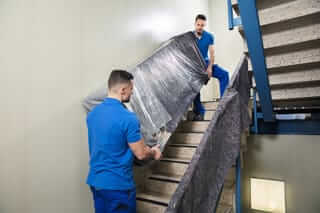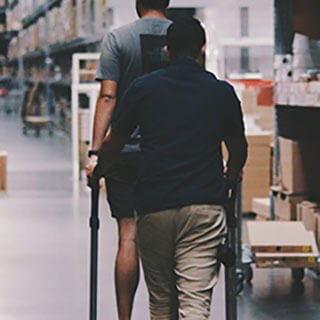Moving house can be quite a task. But when your cargo includes precious artwork, the process can seem even more daunting. Whether you’re a passionate collector, a casual art enthusiast, or just a proud owner of a few cherished pieces, relocating your art requires careful forethought and expert hands. So, this article will shed light on how to navigate the complexities of art relocation.
Required supplies
Before you make any moves and embark on packing your staff, make sure you have the tools for each stage of the art relocation process:
| Pre-packing | Packing | Transportation |
|---|---|---|
| A notebook or any app that allows making notes — to examine your collection and note down the condition of every piece Art gloves — to protect your artwork from oils, dirt, and potential scratches Soft cloths — to gently clean your items before packing | Bubble wrap — to create a protective layer around your artwork Packing paper — to wrap and cushion your art pieces Cardboard corners — to provide additional protection for your framed artwork Tape — to secure bubble wrap and cardboard corners in place Boxes of different sizes — to accommodate different artworks | Moving blankets — to wrap large pieces of art or to create a cushioned barrier between artworks Ratchet straps — to secure your masterpieces inside the vehicle Dolly — to transport larger pieces or sculptures |
Pre-packing tips
Document your collection
Before your precious pieces are enveloped in bubble wrap and nestled into their transportation boxes, take the time to inspect each one thoroughly.
- Note the state of each piece. Are there any existing scratches, marks, or blemishes? Document these details diligently to have a record for future comparisons if needed.
- Capture your artwork in photographs. Each picture should be clear and detailed, covering all angles and specific features of the artwork.
Clean artwork before packing
In the process of moving, cleaning your artwork might seem like an easy step to overlook. However, this simple action can make a significant difference in preserving the quality of your collection. Cleaning before packing ensures dust particles or grime won’t have a chance to damage your art during the move.
- Put on your art gloves. Remember, these gloves protect your artwork from the natural oils and potential dirt on your hands.
- Clean the surface. Using a soft, non-abrasive cloth, gently wipe the surface of each piece. Be especially careful with textured or delicate pieces, ensuring you don’t disrupt any fragile elements.
- For framed pieces, pay particular attention to the glass or acrylic front, ensuring it’s free of smudges and dust. Clean the frame itself, too — a quick wipe will help safeguard against potential damage from accumulated grime.
- For sculptures or other 3D art, carefully clean these pieces, paying attention to crevices and detailed parts. A soft, clean paintbrush will be a helpful tool for reaching those intricate areas.
Decide whether you’ll pack on your own or will hire movers
If you are not certain yet, it’s time to decide how you’ll do the packing — on your own or will work with a moving company.
Packing on your own can seem tempting. Especially if your collection is small or you’re on a tight budget. However, packing art requires a certain level of expertise. Each artwork is unique, and understanding how to correctly pack each piece to prevent damage can be a complex task.
While it’s true that delegating this task to professional movers comes at a cost, the peace of mind knowing that your precious collection is well-protected is priceless. When you choose to trust professionals with your move, do some groundwork. Ensure that the company you select has a proven track record of handling artwork. Discuss your specific needs, any special pieces in your collection, and important moving dates ahead of time.
Check the insurance policy
Verify that your insurance policy provides coverage for your artwork while in transit. This added layer of protection offers further reassurance that your collection will reach its new home safely.
The packing tips
The don’ts of packing
There can be quite the hustle and bustle when it comes to packing. With so many things to organize, categorize and plan, it’s easy to misstep when you’re learning to do things right. Sometimes it gets too late when we know that we’ve made some stupid things — and now we have ruined artwork and a low mood. So, here are the don’ts that will save you some headaches.
- Don’t pack your precious art pieces anywhere in the house — find a neat clean corner with a plain surface.
- Don’t lay your canvas directly on the ground or tabletop — use a firm layer of cushion, bubble wrap, or cover it with newspaper below the surface.
- Don’t nestle multiple artworks in one box — get one box for each art piece to prevent it from getting scratched, torn, punctured, and bearing damages that can’t be fixed.
- Don’t lay other items on your canvas box — avoid putting extra stuff inside the canvas box to avoid dealing with consequences like heavy damage and destruction of your treasured artworks.
How to pack your art collection
Packing artwork is an art in itself, requiring a blend of careful planning and gentle handling. Here’s a step-by-step guide to ensure your precious pieces are well-protected for the journey.
Packing paintings
If the painting has a glass surface, tape it with the painter’s tape. For this, make a large X shape from corner to corner across the glass. This way, even if the glass breaks during transportation, the painter’s tape will prevent it from shattering and damaging the art. Next, cover your artwork with a layer of protective cardboard from both sides. Use bubble wrap to ensure all sides are well-covered and secure with packing tape. Apply cardboard corners for additional protection.
Place your artwork in an art box that best fits its size. If there’s extra space, fill it with packing paper or bubble wrap to ensure the artwork doesn’t shift during transit. Seal the box securely with packing tape.
Packing sculptures or items with unique shapes
Begin by wrapping the entire sculpture carefully with bubble wrap, paying close attention to any protruding or delicate parts. Secure the wrap with packing tape, but ensure the tape doesn’t come into direct contact with the sculpture itself. If there are any hollow spaces or gaps, fill them with additional bubble wrap or packing paper to prevent movement.
Place the wrapped sculpture into an appropriately-sized box, filled with more packing material for added cushioning. Finally, seal the box securely with packing tape.
How to transport artwork safely
Transporting your unique masterpieces is the final step on their way to their new home. Here are the tips that will help you make a smooth last move.
- Secure your artwork inside the moving vehicle. Use moving blankets for added protection and ratchet straps to hold the artwork in place. This prevents any movement that could potentially cause damage during transit.
- Position artwork correctly. Always place it upright and never lay it flat, as this could cause unnecessary pressure or damage.
- Keep the temperature in mind. Artwork, especially pieces created with sensitive materials, can be affected by extreme temperatures. If possible, use a climate-controlled vehicle for transportation.
- Keep artwork separate. If possible, try to transport your artwork in a separate vehicle from your other belongings to minimize the risk of damage.
The final words
Remember, each piece of art is unique and may require specific care during packing. If you’re unsure about any steps or need help with packing your artwork, consider hiring ABA Moving professionals. We have the experience and expertise to ensure your art collection arrives at its new home safely. For more information, reach out to us in any convenient way.









